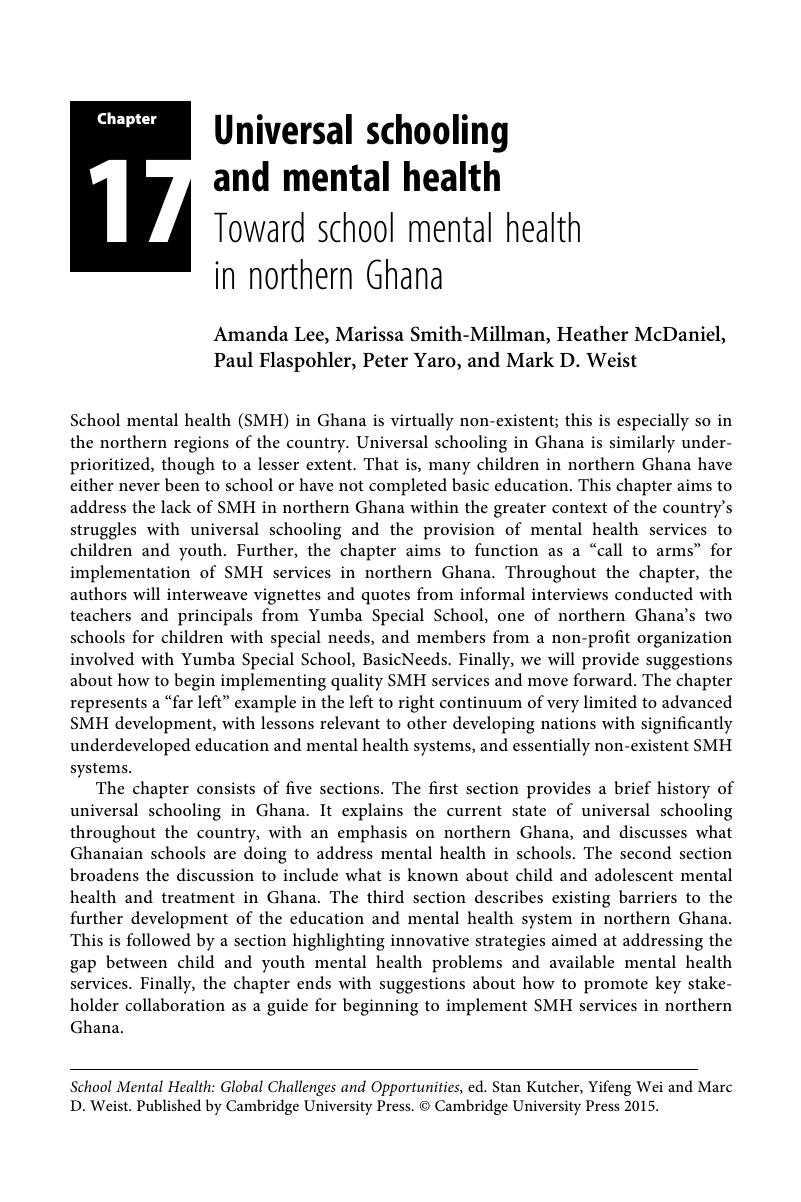Book contents
- School mental healthGlobal challenges and opportunities
- School mental health
- Copyright page
- Dedication
- Contents
- Contributors
- Chapter 1 The global advancement of school mental health for adolescents
- Chapter 2 Developing and sustaining mental health and wellbeing in Australian schools
- Chapter 3 The “Cool Mind” Program (“Programa Cuca Legal”)
- Chapter 4 A collaborative and sustainable approach to address mental health promotion and early identification in schools in the Canadian province of Nova Scotia and beyond
- Chapter 5 The future of teaching mental health literacy in schools
- Chapter 6 School-centered mental health
- Chapter 7 Components of mental healthcare in schools in China
- Chapter 8 Mental health education for children and adolescents in China
- Chapter 9 School mental health programs in India
- Chapter 10 School mental health
- Chapter 11 Supporting a whole-school approach to mental health promotion and wellbeing in post-primary schools in Ireland
- Chapter 12 School mental health in Israel
- Chapter 13 Development of a mental health literacy program for secondary school students in Japan
- Chapter 14 A peer mental health educator model in African schools
- Chapter 15 The current state of school mental health approaches and initiatives in Mexico and Chile
- Chapter 16 Flourishing Schools in Aotearoa, New Zealand
- Chapter 17 Universal schooling and mental health
- Chapter 18 A Singapore model – REACH
- Chapter 19 Improving mental health via schools
- Chapter 20 School and community mental health promotion strategies for youth in Ukraine
- Chapter 21 Innovative contemplative/mindfulness-based approaches to mental health in schools
- Chapter 22 The Life Course Model for providing empirically supported school-based services for adolescents
- Chapter 23 Interconnecting school mental health and school-wide positive behavior support
- Chapter 24 Global school mental health
- Index
- References
Chapter 17 - Universal schooling and mental health
Toward school mental health in northern Ghana
Published online by Cambridge University Press: 05 May 2015
- School mental healthGlobal challenges and opportunities
- School mental health
- Copyright page
- Dedication
- Contents
- Contributors
- Chapter 1 The global advancement of school mental health for adolescents
- Chapter 2 Developing and sustaining mental health and wellbeing in Australian schools
- Chapter 3 The “Cool Mind” Program (“Programa Cuca Legal”)
- Chapter 4 A collaborative and sustainable approach to address mental health promotion and early identification in schools in the Canadian province of Nova Scotia and beyond
- Chapter 5 The future of teaching mental health literacy in schools
- Chapter 6 School-centered mental health
- Chapter 7 Components of mental healthcare in schools in China
- Chapter 8 Mental health education for children and adolescents in China
- Chapter 9 School mental health programs in India
- Chapter 10 School mental health
- Chapter 11 Supporting a whole-school approach to mental health promotion and wellbeing in post-primary schools in Ireland
- Chapter 12 School mental health in Israel
- Chapter 13 Development of a mental health literacy program for secondary school students in Japan
- Chapter 14 A peer mental health educator model in African schools
- Chapter 15 The current state of school mental health approaches and initiatives in Mexico and Chile
- Chapter 16 Flourishing Schools in Aotearoa, New Zealand
- Chapter 17 Universal schooling and mental health
- Chapter 18 A Singapore model – REACH
- Chapter 19 Improving mental health via schools
- Chapter 20 School and community mental health promotion strategies for youth in Ukraine
- Chapter 21 Innovative contemplative/mindfulness-based approaches to mental health in schools
- Chapter 22 The Life Course Model for providing empirically supported school-based services for adolescents
- Chapter 23 Interconnecting school mental health and school-wide positive behavior support
- Chapter 24 Global school mental health
- Index
- References
Summary

- Type
- Chapter
- Information
- School Mental HealthGlobal Challenges and Opportunities, pp. 186 - 201Publisher: Cambridge University PressPrint publication year: 2015



